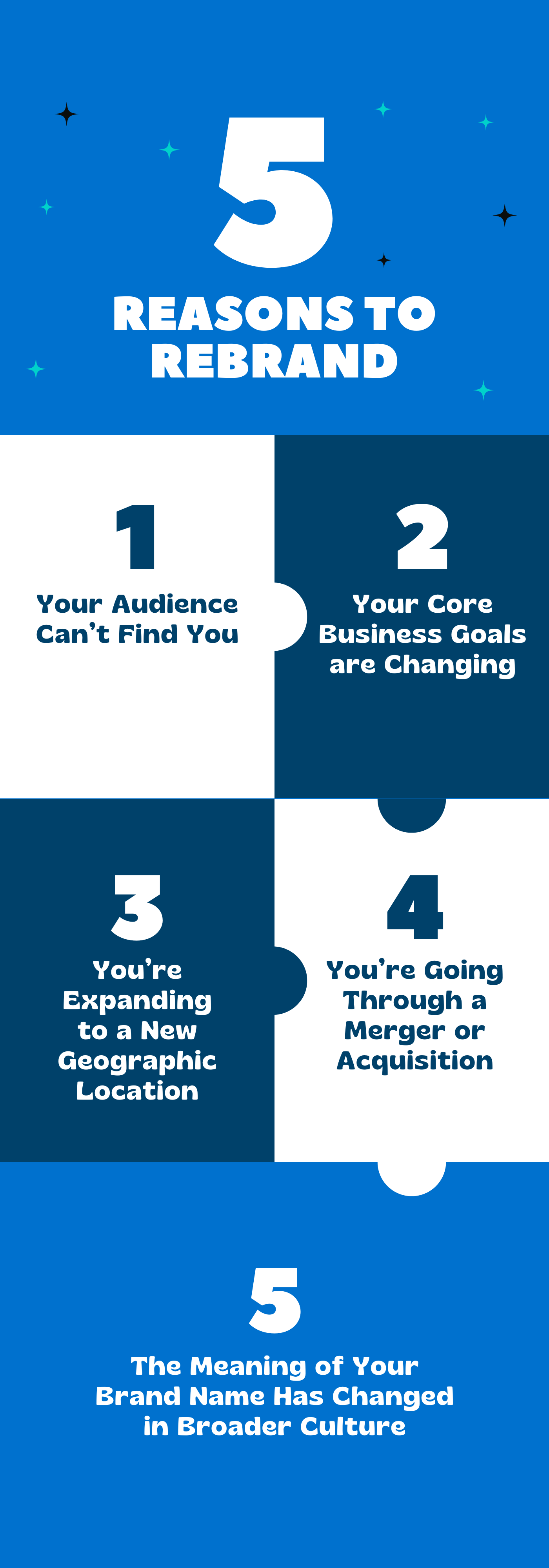Brands have power. They make us feel things–like trust, authority, or expertise. They also make us do things–like wait in line for hours, spend some of our hard-earned savings, or (if we’re part of a B2B organization) sign a multi-year contract that could make or break our annual balance sheet.
And brands don’t just have power over customers. They have power over the people who build them. Companies can’t launch without establishing their brand. A logo and a name can be nostalgic; they are the steadfast iconography that has been part of every company milestone. Which means, for leaders and employees, a brand is kind of like a company’s soul.

When is it Time to Rebrand?
What is a B2B Brand?
It’s not just your logo and name. A brand is your company’s personality–the way in which you present yourself to the world. It’s the tone you use in email copy, the color palette on your website, the images you choose in a premium asset. Any element of your company’s identity that could reach a customer? That is your brand.
For B2B organizations, your brand is most likely practical, authoritative, and knowledgeable. It needs to evoke success, innovation, and competence. Most critically, it needs to appeal to a small, and highly-technical cohort of decision-makers. Your brand won’t have mass appeal. It will have niche appeal.
What Does Rebranding Actually Mean?
Rebranding lives on a spectrum. On one end, it might be as simple as refreshing a logo (Google hasn’t changed its name or URL in three decades, but it has refreshed its logo 6 times) or deleting a “the” in the name (thanks, Sean Parker!).
On the opposite end: a complete visual, verbal, and tonal transformation (You’re probably not familiar with Blue Ribbon Sports. You probably are familiar with this swoosh).
5 Reasons Why it Might be Time for a Change
The decision to rebrand isn’t just enormously risky–a new brand could erase customer recognition, SEO equity, and industry authority. It’s also emotional–every stakeholder in an organization must buy in. And when they don’t, well … Just ask the website formerly known as Twitter.
Why, then, would any company want to take on so much risk?
At Altitude, we’re rebranding experts. We know that tactical or external forces might require you to consider a change. In our experience, these five are the most common.

#1 Your Audience Can’t Find You
In order for you to do business, your customers need to find you. In order to find you, they are most likely typing your name into a search engine or web browser. Make that difficult or confusing and they’ll head to your competition.
The internet hasn’t just changed how we live, work, and play–its changed how we name things. Many of our clients were founded pre-internet age, and in the B2B space especially, were slow to adopt digital branding best practices. In these situations, we see three major challenges:
- You don’t own a logical URL: Like oceanfront property, the internet has more valuable and less valuable real estate. Ideally, you already own COMPANYNAME.com. But your name might be generic, or highly valuable for another industry. The more you have to evolve your URL away from your core name, the harder it is for customers to find you. Making a change to get a .com that precisely matches your brand can be super valuable for inbound traffic.
- Your name matches a more prominent brand in a different industry: There’s a reason Apple Manufacturing does not exist. Brand equity in a completely different sector still has the power to push your identity into the depths of search-engine purgatory.
- Your name has special characters: Like Yahoo’s exclamation point or Dunkin’s apostrophe, you might be stuck with a special character that doesn’t play well with our digital ecosystem (both those brands eventually erased theirs). Things like a question mark (?) or backslash (/) actually trigger action in web browsers. Eliminating them from a pre-internet brand name automatically increases discoverability, and decreases customer annoyance.
#2 Your Core Business Goals are Changing
Imagine building a product for a specific sector that’s so successful, other sectors want in on the action. PlateIQ did that, creating an automated AP solution for restaurants. They outgrew the kitchen and needed a name that could work just as well for a construction CFO as a family-run diner.
They trusted Altitude to get the job done, which is how we helped them relaunch as Ottimate in 2023. Their new name isn’t just clever (but we will pat ourselves on the back for it), it allows them to play in fields they didn’t even know existed when they launched.
Pivots are part of entrepreneurship. And they can lead to fantastic results. But if you’re in the middle of one, a complete rebrand might be necessary in order to keep pace with your evolving product or growing target audience.
#3 You’re Expanding to a New Geographic Location
When you grow outside of your region, country, or even hemisphere, you need to be cognizant of how your brand is perceived in another language and culture. The growth potential of that region might be valuable, but your visual and verbal identity could start you off on the wrong foot. Some companies might opt to launch a region-specific brand, or if they find value, completely pivot their existing identity to appeal to a broader audience.
Either way, when your business grows, your brand might need to do the same.
#4 You’re Going Through a Merger or Acquisition
Like a marriage, both parties of an M&A bring brand value. The challenge is figuring out the right balance–after all, you probably don’t want to move in with two toasters. When a parent company wants to preserve or retain equity in their new acquisition, they need to figure out what elements to retain, and which to scrap.
In some cases, the rebrand might include identities from both brands or a completely new identity that merges the strengths from each.
#5 The Meaning of Your Brand Name Has Changed in Broader Culture
There’s an entire Wikipedia page dedicated to companies that used to be called “Isis,” after the Egyptian goddess. For obvious–but incredibly unfortunate and unlucky–reasons, those organizations needed to swiftly rebrand.
Language changes. And your company might, because of forces outside your control, have to change with it.
Conclusion: Rebranding is Risky. It Might Also Be Necessary.
The process of rebranding is challenging. Making the decision to start might be more so. When customer loyalty and emotional value are at stake, a full rebrand might be the most consequential moment in your organization’s history. That’s why it is never taken lightly.
It’s also why it takes a team of experts–like Altitude–to make your next era more successful than your last.
We help leading business-to-business brands hit their marketing goals. Get in touch to learn how Altitude Marketing can help you reach your peak performance.



